
The superfamily Apoidea is a major group within the Hymenoptera, which includes two traditionally recognized lineages, the "sphecoid" wasps, and the bees. Molecular phylogeny demonstrates that the bees arose from within the traditional "Crabronidae", so that grouping is paraphyletic, and this has led to a reclassification to produce monophyletic families.
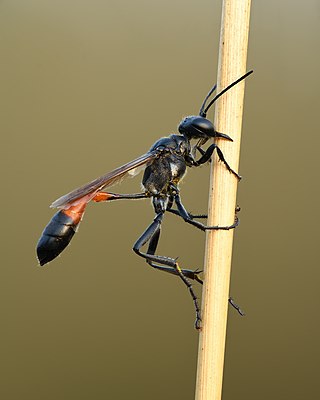
The Sphecidae are a cosmopolitan family of wasps of the suborder Apocrita that includes sand wasps, mud daubers, and other thread-waisted wasps.
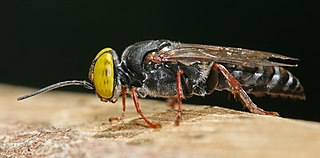
The Crabronidae are a large paraphyletic group of wasps, including nearly all of the species formerly comprising the now-defunct superfamily Sphecoidea. It collectively includes well over 200 genera, containing well over 9000 species. Crabronids were originally a part of the Sphecidae, but the latter name is now restricted to a separate family based on what was once the subfamily Sphecinae. Several of the subfamilies of the Crabronidae are often treated as families in their own right, as is true of the most recent phylogenies.

Pison is a cosmopolitan genus of wasps within the family Crabronidae. The genus comprises 145 described species, although many species, especially in South America remain undescribed.
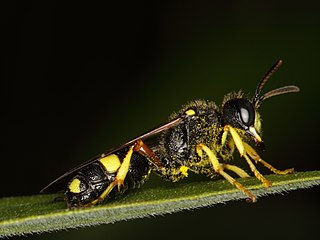
Cerceris is a genus of wasps in the family Crabronidae. It is the largest genus in the family, with over 1030 described species and subspecies. The genus has a cosmopolitan distribution, with species on every continent.

A wasp is any insect of the narrow-waisted suborder Apocrita of the order Hymenoptera which is neither a bee nor an ant; this excludes the broad-waisted sawflies (Symphyta), which look somewhat like wasps, but are in a separate suborder. The wasps do not constitute a clade, a complete natural group with a single ancestor, as bees and ants are deeply nested within the wasps, having evolved from wasp ancestors. Wasps that are members of the clade Aculeata can sting their prey.

Xanthocryptus novozealandicus, the lemon tree borer parasite, is a wasp in the family Ichneumonidae. It is a native insect of New Zealand. It is also found in Australia and New Guinea. Females hunt for larvae of wood-boring beetles around March, including the lemon tree borer, a native cerambycid that tunnels into citrus trees, grapes and many native species. When a suitable host is found, the female pushes her ovipositor through the wood and injects her eggs into the grub. This has the incidental benefit of helping to control some pests. X. novozealandicus prefers to prey on second year lemon tree borer larvae. This specific parasite prefers to prey on larger second year larvae due to its larger size.

Sphecius grandis, also called the western cicada killer, is a species of cicada killer wasp (Sphecius). The western species shares the same nesting biology as its fellow species, the eastern cicada killer. S. grandis, like all other species of the genus Sphecius, mainly provides cicadas for its offspring. It forms nest aggregations and mates and broods once in a year, in July and early August. The wasp is on average 3 cm (1 in) to 5 cm (2 in) in length and is amber-yellow with yellow rings on its abdomen.
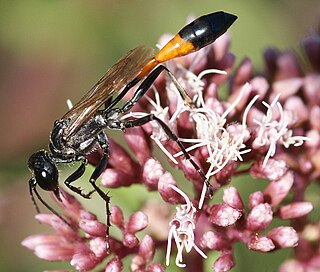
Ammophila sabulosa, the red-banded sand wasp, is a species of the subfamily Ammophilinae of the solitary hunting wasp family Sphecidae, also called digger wasps. Found across Eurasia, the parasitoid wasp is notable for the mass provisioning behaviour of the females, hunting caterpillars mainly on sunny days, paralysing them with a sting, and burying them in a burrow with a single egg. The species is also remarkable for the extent to which females parasitise their own species, either stealing prey from nests of other females to provision their own nests, or in brood parasitism, removing the other female's egg and laying one of her own instead.

Socca pustulosa is a Orb-weaver spider species in the family Araneidae, and it was first described by a French scientist Charles Athanase Walckenaer in 1841 from Tasmania, Australia, but later on when Walckenaer examined the specimen collected from New Zealand and renamed it as a different species- Epeira verrucosa. Until 1917, Dalmas reviewed the Australian pustulosa and New Zealand verrucosa and realized they were the same species. Although S. pustulosa has been accepted for some time in the genus of Eriophora, the evidence supporting its placement within this genus were not fully convincing. Therefore, an alternative view was proposed in 2022- a new genus established to accommodate pustulosa along with 11 other spider species from Australia; the diagnostic test based on haplotype analysis and systematic morphology study by arachnologists and found the anatomical features of male pedipalp terminal apophysis differs from other orb-web species.

Psenulus is a genus of wasps in the family Crabronidae. The 160 species are found worldwide, but are best represented in the Indomalayan realm with 68. The Palearctic has 26, the Nearctic 4, and the Australasian realm 3. Psenulus is largely absent from South America and entirely absent from Melanesia and Polynesia. A recent phylogenetic analysis provided strong evidence that this genus is the closest living relative to bees.
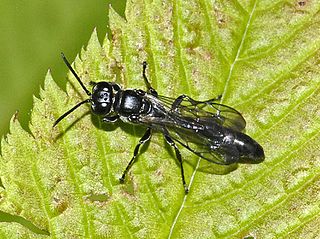
Trypoxylon is a genus of wasps in the family Crabronidae. All Trypoxylon species that have been studied so far are active hunters of spiders, which they paralyse with a venomous sting, to provide as food to their developing larvae. Depending on the species, they will either construct their own nest from mud or find cavities that already exist. These cavities can range from keyholes to nail holes to previously abandoned nests, and are generally sealed with mud to create cells for their larvae.

Pison spinolae, commonly known as mason wasp, is a solitary wasp of the family Crabronidae, found throughout New Zealand.
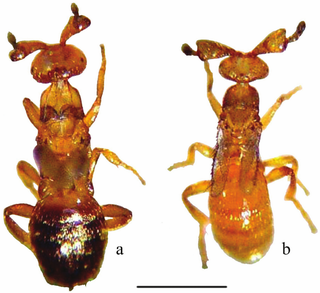
Melittobia australica is a species of chalcid wasp from the family Eulophidae which is a gregarious ecto-parasitoid of acuealate Hymenoptera.
Pison koreense is a species of square-headed wasp in the family Crabronidae. It is found in Europe and Northern Asia, North America, and Southern Asia.
Jacqueline Rae Beggs is a New Zealand entomologist and ecologist specialising in biodiversity and biosecurity.
A list of the species of Hymenoptera from New Zealand; currently listing the 'stinging wasps' (Aculeata), which includes ants, bees, and social wasps.

Maratus griseus, the white-banded house jumping spider, is a species of jumping spider in the family Salticidae. It is found in Australia and New Zealand.

Pison morosum is a solitary wasp of the family Crabronidae. It is the only endemic species of Pison wasp to New Zealand. It was first described by entomologist Frederick Smith in 1858.
Pison marginatum is a wasp of the family Crabronidae. It is found in Australia, South East Asia and many of the islands of the Pacific Ocean.

















